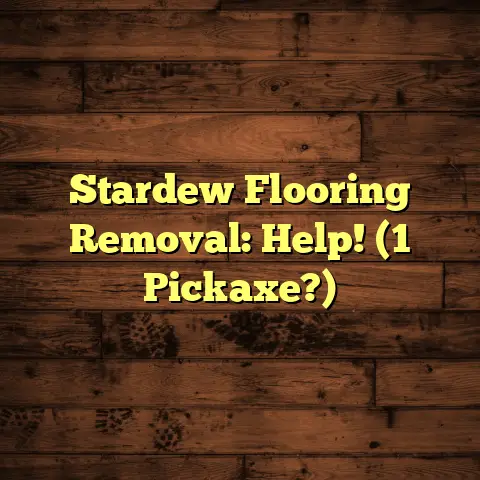Fill Gaps In Floorboards: Easy? (7 Quick Fixes)
Expert Tip: Listen, as a seasoned flooring contractor, I’ve seen it all. One thing I always tell homeowners is don’t ignore those gaps in your floorboards!
It’s not just about looks, it’s about keeping your home comfortable, saving energy, and preventing unwanted guests (think creepy crawlies). You might think fixing them is a huge hassle, but trust me, there are some surprisingly easy fixes you can tackle yourself.
Section 1: Understanding the Problem
What Causes Gaps in Floorboards?
Alright, so why do these annoying gaps even appear in the first place? Well, wood is a natural material, and like anything natural, it reacts to its environment. Here’s the lowdown:
-
Natural Wood Expansion and Contraction: Think of wood like a sponge. When it’s humid, it soaks up moisture and expands. When it’s dry, it releases moisture and shrinks. This constant movement is a major culprit.
- Example: I’ve seen floors laid in the humid summer months shrink dramatically come winter, leaving noticeable gaps.
-
Humidity Levels: Speaking of humidity, drastic changes are a floor’s worst enemy. Consistent humidity is key, but that’s not always easy to control.
- Data: According to the EPA, ideal indoor humidity is between 30-50%. Staying within this range will definitely help minimize wood movement.
- Source: https://www.epa.gov/
- Data: According to the EPA, ideal indoor humidity is between 30-50%. Staying within this range will definitely help minimize wood movement.
-
Age of the Flooring: Older floors have been through more expansion and contraction cycles. Over time, the boards can lose their tight fit. Plus, older adhesives can weaken.
-
Poor Installation: I can’t stress this enough: a bad install is a recipe for gaps. If the boards weren’t properly acclimated to the home’s humidity before installation, or if they weren’t spaced correctly, gaps are almost guaranteed.
- Personal Story: I once had to redo an entire floor because the original installers rushed the acclimation process. Huge gaps appeared within months!
Why It Matters to Fill the Gaps
Okay, so you have gaps. Big deal, right? Wrong! Here’s why filling those gaps is crucial:
-
Improved Comfort: Those gaps let in cold drafts in the winter, making your home feel chilly and uncomfortable.
-
Energy Efficiency: Drafts mean your heating system has to work harder to maintain a comfortable temperature. Filling the gaps can save you money on your energy bill.
- Fact: The U.S. Department of Energy estimates that drafts can increase energy consumption by 5-30%.
-
Enhanced Aesthetics: Let’s face it, gaps just look bad. They detract from the beauty of your wood floors and can make your home look unkempt.
-
Pest Problems: Gaps are like open invitations for insects and other pests to move in. They provide shelter and easy access to your home.
-
Increased Heating Costs: As mentioned, drafts increase your energy usage. Sealing those gaps is a smart financial move.
Section 2: Overview of Quick Fixes
Alright, let’s get to the good stuff! Here are seven quick fixes I’ve used over the years to tackle those pesky floorboard gaps:
- Wood Filler: A classic for a reason! Great for smaller gaps and comes in a variety of colors to match your floor.
- Caulk: Flexible and easy to apply, perfect for gaps along walls or baseboards.
- Floorboard Strips: Thin strips of wood that can be inserted into larger gaps for a seamless look.
- Wood Shim: Tapered pieces of wood used to fill gaps and provide support.
- Expandable Foam: For those really big gaps, expandable foam can be a quick (but sometimes messy) solution.
- Repositioning Floorboards: Sometimes, the best fix is to simply move the existing boards back into place.
- Professional Help: When all else fails, or if you’re dealing with extensive damage, it’s time to call in the pros.
Section 3: Fix #1 – Use Wood Filler
Wood filler is a staple in any flooring contractor’s toolkit. It’s relatively inexpensive, easy to use, and can be a great solution for smaller gaps.
-
Selecting the Right Wood Filler:
- Color: Choose a filler that closely matches the color of your floor. You can find fillers in a variety of wood tones, or even tint them yourself.
- Type: There are two main types of wood filler: water-based and solvent-based. Water-based fillers are easier to clean up and are less smelly, but solvent-based fillers tend to be more durable.
- Grain: Consider a grain filler if your wood has an open grain like oak or ash. This will help create a smoother, more even surface.
-
Step-by-Step Guide to Applying Wood Filler:
- Clean the Area: Thoroughly clean the area around the gap with a vacuum cleaner and a damp cloth. Remove any loose debris or old finish.
- Apply the Filler: Use a putty knife to apply the wood filler to the gap. Overfill the gap slightly, as the filler will shrink as it dries.
- Let it Dry: Allow the filler to dry completely according to the manufacturer’s instructions. This can take anywhere from a few hours to overnight.
- Sand it Smooth: Once the filler is dry, sand it smooth with fine-grit sandpaper (120-grit or higher). Be careful not to sand away the surrounding wood.
- Finish it: Apply a finish that matches your existing floor. This could be a stain, varnish, or polyurethane.
-
Tips for Effective Application:
- Work in thin layers: Applying the filler in thin layers will help prevent cracking and ensure a more even finish.
- Use a flexible putty knife: A flexible putty knife will allow you to apply the filler more precisely.
- Don’t be afraid to experiment: If you’re not happy with the results, you can always sand down the filler and try again.
Section 4: Fix #2 – Caulk the Gaps
Caulk is another great option for filling smaller gaps, especially those along walls or baseboards. It’s flexible, easy to apply, and comes in a variety of colors.
-
Benefits of Using Caulk:
- Flexibility: Caulk is more flexible than wood filler, which makes it a good choice for areas that are subject to movement.
- Water Resistance: Caulk is water-resistant, which makes it a good choice for areas that are exposed to moisture.
- Ease of Application: Caulk is easy to apply with a caulking gun.
-
Detailed Tutorial on How to Use Caulk:
- Choose the Right Caulk: Select a caulk that is paintable and matches the color of your floor or trim. Acrylic latex caulk is a good all-around choice.
- Prepare the Area: Clean the area around the gap with a vacuum cleaner and a damp cloth. Remove any loose debris or old caulk.
- Load the Caulking Gun: Cut the tip of the caulk tube at a 45-degree angle. Puncture the seal inside the tube with a nail or wire. Load the tube into the caulking gun.
- Apply the Caulk: Hold the caulking gun at a 45-degree angle and apply a bead of caulk along the gap. Apply even pressure to create a smooth, consistent bead.
- Smooth the Caulk: Use a wet finger or a caulk smoothing tool to smooth the bead of caulk.
- Clean Up: Wipe away any excess caulk with a damp cloth.
- Allow to Dry: Allow the caulk to dry completely according to the manufacturer’s instructions.
-
Tips for Choosing and Applying Caulk:
- Use a high-quality caulk: A high-quality caulk will last longer and provide a better seal.
- Cut the tip of the tube at the right angle: Cutting the tip of the tube at a 45-degree angle will make it easier to apply the caulk smoothly.
- Keep a damp cloth handy: A damp cloth will help you clean up any excess caulk.
Section 5: Fix #3 – Floorboard Strips
For larger gaps, floorboard strips can be a great solution. These are thin strips of wood that are inserted into the gaps to create a seamless look.
-
How Floorboard Strips Can Be Used:
- Covering Larger Gaps: Floorboard strips are ideal for gaps that are too wide for wood filler or caulk.
- Creating a Seamless Look: When installed properly, floorboard strips can blend in seamlessly with the existing floor.
-
Guide on Measuring, Cutting, and Installing Strips:
- Measure the Gaps: Carefully measure the width and depth of the gaps you want to fill.
- Choose the Right Wood: Select a wood that matches the type and color of your existing floor.
- Cut the Strips: Cut the strips to the correct width and length using a saw. Be sure to cut them slightly wider than the gap to ensure a snug fit.
- Apply Adhesive: Apply a thin bead of wood glue to the edges of the strips.
- Insert the Strips: Carefully insert the strips into the gaps. Use a rubber mallet to gently tap them into place.
- Sand and Finish: Once the glue is dry, sand the strips smooth with fine-grit sandpaper. Apply a finish that matches your existing floor.
-
Achieving a Seamless Appearance:
- Choose the right wood: Selecting a wood that closely matches your existing floor is crucial for a seamless look.
- Sand carefully: Sanding the strips smooth will help them blend in with the surrounding floor.
- Apply the finish properly: Applying the finish evenly will help create a uniform appearance.
Section 6: Fix #4 – Use a Wood Shim
Wood shims are tapered pieces of wood that can be used to fill gaps and provide support. They’re particularly useful for gaps that are uneven or require some adjustment.
-
Introducing Wood Shims:
- Adjusting and Filling Gaps: Shims can be used to fill gaps of varying widths.
- Providing Support: Shims can also provide support to loose or sagging floorboards.
-
Instructions on Inserting Shims:
- Select the Right Shims: Choose shims that are slightly wider than the gap you want to fill.
- Insert the Shims: Insert the shims into the gap, with the tapered end facing down.
- Adjust the Shims: Adjust the shims until they are flush with the surface of the floor.
- Secure the Shims: Secure the shims with wood glue or nails.
- Trim the Shims: Trim any excess shim material with a utility knife or saw.
- Sand and Finish: Sand the shims smooth and apply a finish that matches your existing floor.
-
Securing Shims Effectively:
- Use wood glue: Wood glue will help hold the shims in place and prevent them from shifting.
- Use nails: Nails can provide additional support, especially for larger gaps.
- Trim carefully: Trimming the shims carefully will help them blend in with the surrounding floor.
Section 7: Fix #5 – Expandable Foam
For larger gaps, especially those around pipes or other obstructions, expandable foam can be a quick and easy solution. However, it’s important to use it carefully, as it can be messy and difficult to remove.
-
Application of Expandable Foam:
- Filling Larger Gaps: Expandable foam is ideal for filling gaps that are too large for wood filler, caulk, or floorboard strips.
- Sealing Around Obstructions: Expandable foam can also be used to seal gaps around pipes, wires, and other obstructions.
-
Safety Precautions:
- Wear gloves and eye protection: Expandable foam can be irritating to the skin and eyes.
- Work in a well-ventilated area: Expandable foam releases fumes that can be harmful to breathe.
- Avoid contact with skin and clothing: Expandable foam is difficult to remove once it has dried.
-
Application Techniques:
- Prepare the Area: Clean the area around the gap with a vacuum cleaner and a damp cloth.
- Apply the Foam: Apply the foam according to the manufacturer’s instructions. Be careful not to overfill the gap, as the foam will expand as it dries.
- Allow to Dry: Allow the foam to dry completely according to the manufacturer’s instructions.
- Trim the Excess: Trim any excess foam with a utility knife.
- Cover the Foam: Cover the foam with a piece of trim or molding to conceal it.
-
Finishing Tips:
- Use a low-expansion foam: Low-expansion foam is less likely to overfill the gap and cause damage.
- Apply the foam in thin layers: Applying the foam in thin layers will help prevent it from expanding too quickly.
- Protect the surrounding surfaces: Cover the surrounding surfaces with plastic or paper to protect them from the foam.
Section 8: Fix #6 – Repositioning Floorboards
Sometimes, the best solution is to simply reposition the existing floorboards. This is especially true if the gaps are caused by loose or shifted boards.
-
When to Reposition Floorboards:
- Loose or Shifted Boards: If the gaps are caused by loose or shifted boards, repositioning them can be a quick and easy fix.
- Minimal Damage: If the floorboards are in good condition and there is minimal damage, repositioning them is a good option.
-
Steps Involved in Loosening and Reseating:
- Identify the Loose Boards: Identify the floorboards that are loose or shifted.
- Remove the Baseboards: Remove the baseboards or trim around the perimeter of the room.
- Loosen the Boards: Use a pry bar or a hammer and chisel to gently loosen the boards.
- Reposition the Boards: Reposition the boards so that they are flush with the surrounding floor.
- Secure the Boards: Secure the boards with nails or screws.
- Reinstall the Baseboards: Reinstall the baseboards or trim around the perimeter of the room.
-
Tools Needed:
- Pry Bar: A pry bar is used to loosen the floorboards.
- Hammer: A hammer is used to tap the floorboards into place.
- Chisel: A chisel is used to remove any excess wood or debris.
- Nails or Screws: Nails or screws are used to secure the floorboards.
- Nail Gun or Screwdriver: A nail gun or screwdriver is used to drive the nails or screws.
Section 9: Fix #7 – Professional Help
While many of these fixes are DIY-friendly, there are times when calling in a professional is the best course of action.
-
When to Call a Professional:
- Extensive Gaps: If you have extensive gaps throughout your floor, it’s best to call a professional.
- Structural Issues: If the gaps are caused by structural issues, such as a sagging subfloor, you’ll need to call a professional to assess the situation and make repairs.
- Lack of Experience: If you’re not comfortable working with tools or you’re unsure about the best way to fix the gaps, it’s best to call a professional.
-
Benefits of Seeking Expert Advice:
- Proper Diagnosis: A professional can properly diagnose the cause of the gaps and recommend the best course of action.
- Quality Workmanship: A professional will have the skills and experience to do the job right, ensuring a long-lasting repair.
- Peace of Mind: Hiring a professional can give you peace of mind knowing that the job is being done correctly.
Conclusion:
So, there you have it! Seven quick fixes for filling those annoying gaps in your floorboards. As you can see, the choice of method really depends on the size and severity of the gaps, as well as the type of flooring you have. Don’t be afraid to try a few different methods to see what works best for you.
Call to Action:
Now it’s your turn! Take a good look at your floors. Do you see any gaps that need attention? Consider which of these fixes might be the best fit for your situation. And hey, if you have any questions or want to share your own experiences, drop a comment below! I’m always happy to help.





